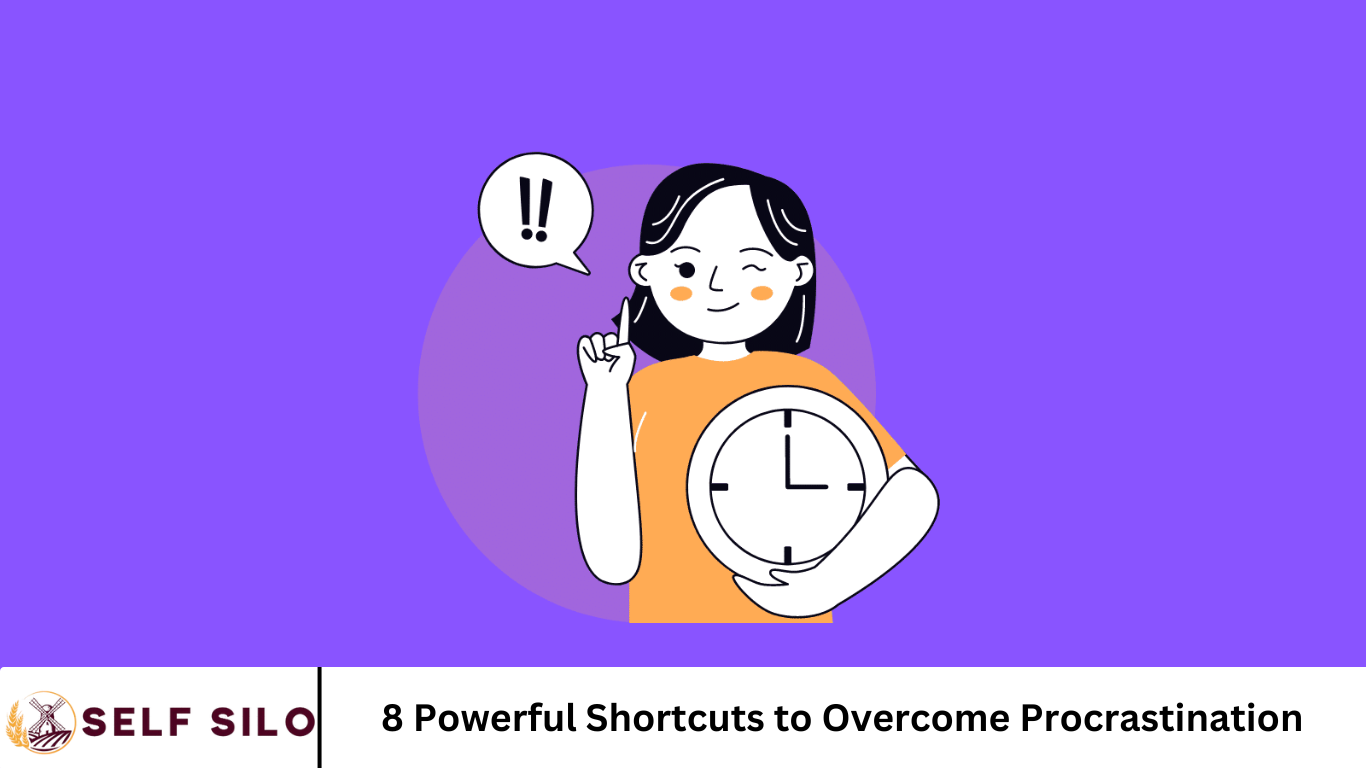Procrastination is one of the biggest productivity killers known to humankind. Whether it’s putting off a work project, delaying fitness goals, or ignoring household chores, procrastination can silently sabotage our success. But here’s the good news: overcoming procrastination is possible.
And it doesn’t require a massive life overhaul. Instead, a few powerful shortcuts can make all the difference. In this article, you’ll discover 8 powerful shortcuts to overcome procrastination. These strategies are designed to help you act decisively, build better habits, and reclaim your time.
More Read: Understanding Growth vs Fixed Mindset: What’s the Real Difference?
1. Use the 2-Minute Rule
The 2-minute rule is simple but incredibly effective: if a task takes two minutes or less to complete, do it immediately. This technique, made popular by productivity expert David Allen, works because it helps you build momentum.
Tasks like replying to an email, making your bed, or taking out the trash often take less time than we think. Yet we delay them, allowing them to pile up and create mental clutter.
Why it works:
- It lowers the barrier to getting started.
- It creates a sense of accomplishment.
- It prevents small tasks from becoming overwhelming.
Try this today: Look around and complete five tasks that take under two minutes. Watch how much lighter your mental load feels.
2. Time Block Your Day
One of the most effective ways to stop procrastinating is to assign time slots to specific tasks. Time blocking transforms vague intentions into clear commitments.
Rather than saying, “I’ll work on that presentation tomorrow,” say, “I’ll work on the presentation from 10 a.m. to 11 a.m.”
How to do it:
- Break your day into hourly or half-hour segments.
- Assign a task or focus to each block.
- Leave buffer time between blocks to avoid burnout.
Bonus tip: Use color-coded calendars to visually distinguish work, personal, and relaxation blocks. This makes it easier to stick to your schedule.
3. Set Micro-Goals
Big tasks can feel overwhelming. That’s why breaking them into small, manageable steps is a powerful shortcut to overcoming procrastination.
For example, instead of “write a 20-page report,” set a micro-goal like “write the outline” or “draft the introduction.”
Why it works:
- Micro-goals reduce anxiety.
- They create a clear starting point.
- Progress feels immediate and motivating.
Each small win fuels the next step, turning a daunting task into a series of simple actions.
4. Leverage the Power of Deadlines
Even self-imposed deadlines can dramatically boost productivity. Our brains respond to urgency, and a clear deadline provides the pressure needed to get moving.
Try this:
- Set a timer for 25 minutes (a technique known as the Pomodoro Technique).
- Work on a task without distraction until the timer goes off.
- Take a 5-minute break.
Why this works:
- It creates a sense of urgency.
- It builds focus and eliminates multitasking.
- The countdown encourages action, not delay.
Deadlines convert abstract goals into concrete action plans.
5. Eliminate Distractions
Procrastination often thrives in an environment filled with distractions. Social media, emails, text messages, and clutter all pull your attention away from what matters.
Create a distraction-free zone by:
- Turning off notifications.
- Using apps like Freedom or Cold Turkey to block distracting websites.
- Cleaning your workspace before beginning a task.
Bonus: Keep only one tab open on your browser while working. The fewer options your brain has to wander, the more likely you’ll stay focused.
6. Reward Yourself
We’re more likely to take action when there’s a reward waiting at the end. Set up a system of small incentives for completing tasks.
For example:
- “When I finish this proposal, I’ll watch an episode of my favorite show.”
- “Once I hit my word count for the day, I’ll take a walk or get a coffee.”
Why it works:
- It turns work into a game.
- It trains your brain to associate productivity with pleasure.
- It builds a habit loop of cue, action, and reward.
Use rewards strategically to turn motivation into momentum.
7. Visualize the Consequences of Delay
One of the best ways to overcome procrastination is to imagine the negative consequences of not acting.
Ask yourself:
- What happens if I keep putting this off?
- How will it affect my goals, income, or relationships?
- Will I regret not taking action today?
Why this works:
- It shifts your focus from short-term comfort to long-term cost.
- It creates a sense of urgency and accountability.
- It taps into emotional motivation.
Fear of regret is a powerful motivator. Use it wisely.
8. Build a Habit Stack
A “habit stack” is when you attach a new habit to an existing one. This makes it easier to automate action and eliminate procrastination.
Example:
- After I brew my morning coffee (existing habit), I’ll spend 10 minutes reviewing my to-do list (new habit).
- After I brush my teeth at night, I’ll prep my clothes for the next day.
Why this works:
- It piggybacks on a routine that already exists.
- It reduces the need for motivation or willpower.
- It turns productivity into autopilot.
Habit stacking is the foundation of lasting change.
Frequently Asked Question
What are the best shortcuts to overcome procrastination?
The best shortcuts include the 2-minute rule, time blocking, setting micro-goals, using self-imposed deadlines, eliminating distractions, rewarding yourself, visualizing consequences, and habit stacking. These strategies help rewire your daily behavior and make productivity automatic.
How does the 2-minute rule help with procrastination?
The 2-minute rule encourages you to immediately complete any task that takes two minutes or less. This reduces mental clutter, builds momentum, and makes it easier to transition into more significant tasks without delay.
Why is time blocking effective for beating procrastination?
Time blocking assigns specific time slots to tasks, removing ambiguity and promoting commitment. This structure eliminates decision fatigue and keeps you accountable throughout the day.
Can small rewards really increase productivity?
Yes, small rewards act as positive reinforcement. By linking a task with an enjoyable activity, your brain begins to associate productivity with pleasure, making it more likely you’ll take action again.
What is a habit stack, and how does it work?
A habit stack is when you attach a new habit to an existing one. For example, reviewing your to-do list right after making coffee. This piggyback approach makes the new habit easier to adopt and sustain.
What’s the role of deadlines in overcoming procrastination?
Deadlines—especially self-imposed ones—create urgency and a sense of focus. Techniques like the Pomodoro Method (25-minute focused sprints) turn time into a motivator rather than a source of stress.
Can visualization really reduce procrastination?
Yes. By imagining the consequences of continued delay—missed opportunities, stress, lost income—you activate emotional motivation. This mindset shift makes procrastination feel riskier than taking action.
Conclusion
Procrastination doesn’t mean you’re lazy. It often means you’re overwhelmed, unmotivated, or unsure of where to start. The key is to simplify the process. By using these 8 powerful shortcuts to overcome procrastination, you’ll gradually rewire your brain for action. You’ll spend less time stressing and more time doing. And over time, these small steps will lead to big results. Here’s your challenge: pick one shortcut from this list and apply it today. Don’t wait for the perfect moment. Start now. Momentum builds quickly once you take the first step.


